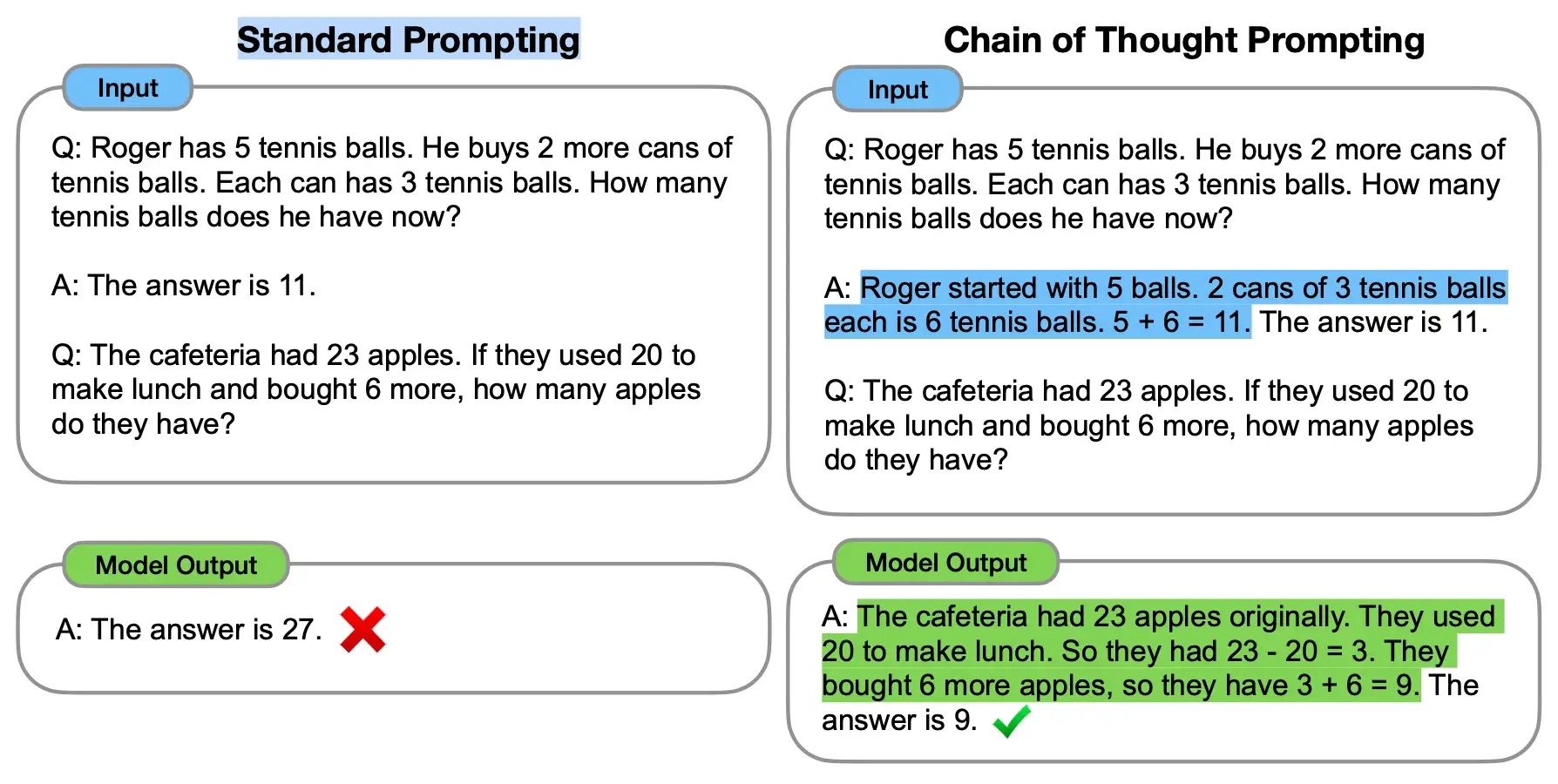Chain of Thought Prompting (CoT)
Chain-of-Thought (CoT) prompting is a popular technique designed to enhance reasoning capabilities in large language models (LLMs). By breaking down complex tasks into structured, sequential steps, CoT prompts allow AI systems to achieve more accurate and coherent outputs. Introduced by Wei et al. (2022)1 in their paper "Chain-of-Thought Prompting Elicits Reasoning in Large Language Models"1, this method highlights how structured reasoning dramatically improves performance, especially in tasks requiring multi-step thinking. In this article, you will learn how chain-of-thought prompting works, as well as its applications, benefits, and limitations.
What is Chain-of-Thought Prompting?
Chain-of-Thought (CoT)1 structures AI responses by breaking complex problems into sequential reasoning steps. This chain of reasoning allows large language models (LLMs) to handle tasks requiring step thinking, making them more capable of producing logical and coherent outcomes rather than giving a direct answer. step thinking, making them more capable of producing logical and coherent outcomes rather than giving a direct answer.
CoT is the primary technique used in OpenAI’s reasoning models, which includes the o1 model series. These are designed to think before they answer, and can produce a long internal chain of thought before responding to the user. As a result, they excel in scientific reasoning, with o1 ranking in the 89th percentile on competitive programming questions (Codeforces), placing among the top 500 students in the US in a qualifier for the USA Math Olympiad (AIME), and exceeding human PhD-level accuracy on a benchmark of physics, biology, and chemistry problems (GPQA).
How Does Chain-of-Thought Prompting Work?
Chain-of-Thought (CoT) enhances language models by guiding them through a structured process of reasoning. Instead of handling a task in one leap, CoT prompts large language models (LLMs) to generate insights incrementally, improving accuracy and coherence.
1. Explicit Instructions
Explicit CoT involves directly instructing the model to approach problems using step-by-step reasoning. These instructions typically use phrases like "let's think step by step", guiding the model through a logical progression of thought.
For example, when solving a math problem, the model is explicitly prompted to break down the task into manageable steps—first identifying the numbers, then performing the operations in correct order, and finally reaching a conclusion.
2. Implicit Instructions
Implicit CoT is more nuanced, leveraging few-shot prompting or natural language inference to guide the model. Instead of receiving direct step-by-step instructions, the model is presented with examples of reasoning in similar tasks and then expected to generalize that logic to new tasks.
This approach allows models to generate reasoning without explicit prompts, which is especially useful when handling large data sets or tasks where human intervention is minimal.
3. Demonstrative Examples
Imagine a question like; "If a bakery has 18 cupcakes, and they bake 12 more, then sell 15, how many cupcakes are left?" A standard prompt may simply output "The answer is 15".
However, using a chain of thought prompt, the model would reason through the steps: "The bakery started with 18 cupcakes. After baking 12 more, they had 30. They sold 15, so 30 - 15 = 15 cupcakes remain".
This approach is particularly useful for complex enterprise scenarios requiring accurate, stepwise explanations.

Few-Shot Prompting vs Chain-of-Thought Prompting
Few-shot prompting involves giving a language model (LLM) a handful of examples to demonstrate how it should approach a task. While effective for tasks with clear patterns, few-shot prompting often struggles with more complex reasoning problems that require multiple steps, as the model tends to focus on immediate answers rather than underlying processes.
In contrast, Chain-of-Thought (CoT) prompting explicitly guides the model through sequential steps of reasoning. According to Wei et al. (2022), CoT prompts allow models to tackle challenges like arithmetic or logic-based tasks by working through each stage of the problem, as opposed to simply guessing at the final answer.
CoT surpasses few-shot prompting in several domains, such as arithmetic, where breaking down the steps ensures greater accuracy. Similarly, in zero-shot tasks, CoT can perform well without prior examples, making it an excellent choice for dynamic, reasoning-heavy enterprise applications. This makes CoT particularly effective for fields like finance, where multi-step decision-making is critical, or in legal contexts, where logical reasoning is essential.
Another hybrid approach that combines CoT with few-shot learning is Few-shot CoT prompting. In this method, the model is provided with a few examples, each showcasing step-by-step solutions. Research has found that combining few-shot CoT prompting with techniques like retrieval-augmented generation (RAG) or interactive querying further boosts accuracy and reliability, especially when integrated with external knowledge bases or databases.
When Should You Use Chain-of-Thought Prompting?
Chain-of-Thought (CoT) prompting is beneficial for scenarios requiring complex reasoning, logical breakdowns, or ambiguity resolution. Here are three practical examples of when CoT prompting can be particularly effective for LLM applications.
Example 1: Multimodal CoT in Chatbots
In an enterprise chatbot, multimodal chain-of-thought reasoning can combine text with visuals for better customer support.
A prompt might be: "Given this product image and customer query, what are the features of the product? Explain step by step, considering price, material, and availability."
Example 2: Finance Decision Models
In finance, CoT is useful for decision-making models that require multi-step processes.
A CoT prompt could be: "Evaluate the financial health of Company X by considering their quarterly earnings, debt levels, and cash flow. Break down each factor in the analysis before arriving at a conclusion."
Example 3: Healthcare Diagnosis
For healthcare, AI chain of thought logic helps with diagnosing based on patient symptoms.
A prompt might be: "Given a patient's symptoms—fever, headache, and fatigue—analyze potential causes by considering viral infections, immune response, and recent travel history. Provide reasoning for each step."
Different Types of Chain-of-Thought Prompting
Chain-of-Thought (CoT) prompting can be applied in various forms depending on the complexity of the task and the capabilities of the language model. Each variant offers unique advantages and use cases, making them adaptable for different enterprise applications. The three main types of CoT prompting are zero-shot CoT, automatic CoT, and multimodal CoT, each designed to maximize LLM performance in reasoning tasks.
Zero-Shot Chain-of-Thought Prompting
In zero-shot CoT, the model generates reasoning steps autonomously (without any examples), making it ideal for dynamic environments where the model must adapt on the fly. This approach has been shown to be effective in Kojima et al. (2022) and scenarios where fast deployment is required with minimal prompt engineering effort.
Automatic Chain-of-Thought Prompting
Automatic Chain-of-Thought Prompting is a technique where an LLM is used to generate a set of question-answer demonstrations, which are then used as CoT prompts. The model answering the user's question will then decompose the problems into smaller tasks based on these examples. This method can be useful in scenarios where decision-making processes need to be automated, such as in customer support or operational workflows.
Multimodal Chain-of-Thought Reasoning
Multimodal Chain-of-Thought Reasoning combines both text and visual data to enhance a model's ability to process complex, multi-input tasks. For example, a user could upload a photo of a malfunctioning device and describe the issue. The AI could then provide step-by-step troubleshooting instructions, combining visual cues with textual information. This capability is especially useful in technical support, manufacturing, and product maintenance.
Benefits of Chain-of-Thought prompting
Chain-of-Thought prompting brings a range of benefits to foundation models by improving both the depth and accuracy of their responses. Here are four distinct advantages of using CoT prompting:
1. Improved Complex Problem-Solving
CoT helps break down complex problems into manageable steps, allowing LLMs to process information in a more structured way. This is essential for scenarios that require multi-step decision-making, such as financial portfolio management, where each factor—like risk, returns, and market trends—can significantly influence the final investment strategy.
2. Enhanced Reasoning in Large Models
In larger models like PaLM, CoT significantly enhances reasoning capabilities, evaluated using LLM benchmarks. By guiding the model through structured steps, it produces more coherent and accurate results. This improvement is particularly noticeable in tasks that require logical thinking and multi-part answers, as detailed by Wei et al. (2022) in their research on CoT.
3. Reduced Errors in Ambiguous Tasks
CoT's structured reasoning helps reduce errors in tasks that are ambiguous or poorly defined. By explicitly laying out each step of reasoning, the model avoids making incorrect assumptions and provides a more reliable outcome, which is invaluable for certain fields, like diagnostics.
4. Increased Adaptability to Task Types
CoT increases a model's adaptability by enabling it to perform well across different task types, including zero-shot CoT tasks where no prior examples are provided. This makes it a versatile tool for enterprises, where models must handle diverse tasks without retraining.
Limitations of Chain-of-Thought Prompting
While Chain-of-Thought (CoT) prompting enhances reasoning and accuracy, it is not without its limitations, particularly in specific scenarios or smaller models. Recognizing these constraints helps enterprises make informed decisions on when and how to implement CoT effectively.
1. Overwhelms Smaller Models
CoT can be demanding for smaller models with limited processing capacity, as each reasoning step increases the computational load. Models must retain and process multiple steps simultaneously, which can result in slower response times and reduced efficiency, especially in real-time applications. This limitation makes CoT better suited for larger, more powerful models that can handle this complexity.
2. Inconsistent on Non-Reasoning Tasks
For simple, fact-based queries, CoT may overcomplicate the task by introducing unnecessary steps. In these cases, direct-answer models are more efficient, as the problem doesn't require multi-step reasoning. Using CoT in such instances can lead to slower outputs and may confuse the model, detracting from its performance.
3. Dependency on Prompt Engineering
The effectiveness of CoT heavily relies on precise prompt engineering. If the prompts are poorly designed or unclear, the model may generate irrelevant or inefficient reasoning steps, reducing its overall accuracy. This emphasizes the need for expert prompt crafting, ensuring enterprises apply the correct strategies when evaluating LLM applications.
4. Scalability Issues with Large Datasets
CoT can struggle to scale efficiently in environments that deal with large datasets. As the number of reasoning steps grows with the data size, managing this complexity can overwhelm the system, leading to slower performance. This can pose challenges in industries where real-time processing of vast amounts of data is crucial, requiring further optimization of CoT approaches.
Learn more about Chain-of-Thought Prompting
Chain-of-Thought (CoT) prompting offers powerful solutions for enterprises seeking to enhance AI reasoning, problem-solving, and adaptability across diverse applications. Whether you're working with complex decision-making processes, customer support systems, or AI-driven diagnostics, CoT can significantly improve performance. Using Humanloop, enterprises can easily implement chain-of-thought prompts into their LLM applications and monitor their performance. Our platform provides all the tooling necessary to develop, evaluate, and deploy robust LLM applications. Book a demo today to learn more.
Footnotes
-
Chain-of-Thought Prompting Elicits Reasoning in Large Language Models https://arxiv.org/abs/2201.11903 ↩ ↩2 ↩3
About the author

- 𝕏@conorkellyai






